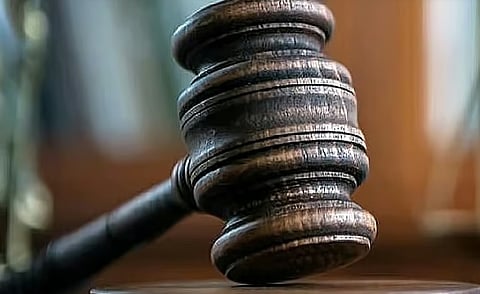

The National Green Tribunal (NGT) September 1, 2025 directed Jammu and Kashmir Lake Conservation and Management Authority (LCMA) and Srinagar Municipal Corporation to take remedial measures for restoration of the Brari Nambal lagoon and disclose the steps which have been taken in this regard in their report.
J&K State Pollution Control Committee (J&KPCC) in the reply dated August 29, 2025 disclosed the status of Brari Nambal. The report mentioned that the area of Brari Nambal Lagoon as per revenue record is 43 hectare, but the GIS image shows the area of the lake is 41.71 ha.
The lagoon is interconnected with Dal Lake through Nowpora channel and is ecologically important as it helps to regulate hydrology of Dal Lake by releasing its surplus waters into river Jhelum via-a conduit at Fateh Kadal area.
During the inspection, it was observed that management of sewage in the Babdem area is poor, as two drains near the Babdem area get emptied into the lagoon which is the main source of the pollution of lagoon.
In the Brari Nambal area, there are two sewage treatment plants (STP) with treatment capacities of 16.1 MLD and 17.1 MLD, it was found. One of these STPs is managed by the LCMA and discharges its treated effluent into the lagoon, while the other, commissioned by the Urban Environmental Engineering Department, releases its treated effluent into both the lagoon and the river Jhelum.
However, neither STP is operating according to the standards set by the NGT. As a result, a significant amount of inadequately treated sewage is being released into the lagoon, leading to a decline in water quality, as indicated by increased levels of biochemical oxygen demand (BOD), chemical oxygen demand (COD) and other nutrient concentrations.
The analysis of water samples from various sites indicated that the water quality at all monitoring points fails to satisfy the primary water quality standards set for Class-B (organized outdoor bathing) concerning dissolved oxygen (DO), BOD and faecal coliform. This is likely due to the discharge of sewage or domestic waste into the waterbody.
The reply by J&KPCC reflects that not only the area of Brari Nambal has been reduced, but it is also affected by the discharge of untreated sewage from non-functional STPs, according to the bench comprising NGT chairperson Justice Prakash Shrivastava and expert members A Senthil Vel and Ishwar Singh.
The National Green Tribunal (NGT) on September 1, 2025, instructed the Union Ministry of Environment, Forest and Climate Change in Dehradun to submit a response regarding the uncontrolled and swift construction activities along the Uttarkashi–Gangotri route in Uttarakhand.
Additionally, the Department of Urban Development, Uttarakhand and the District Magistrate of Uttarkashi were ordered to provide their replies through an affidavit at least one week prior to the next hearing date, set for November 27, 2025.
The matter indicated violation of the provisions of the Environment (Protection) Act, 1986, Solid Waste Management Rules, 2016, Disaster Management Act, 2005 and River Ganga (Rejuvenation, Protection and Management) Authorities Order, 2016, noted NGT.
An application was registered suo motu on the basis of the news item titled Building boom put vulnerable Gangotri Dham at risk: Experts published in the news publication Hindustan Times, August 8, 2025. Experts warned that the unregulated construction is endangering the ecologically fragile Gangotri Dham region.
The article stated that the landscape around the 80km stretch that links Uttarkashi town to Ganagotri Dham has transformed rapidly in the last three decades. Dozens of new constructions were built on the floodplains of the glacier-fed streams.
The article mentioned that, as per a local resident, buildings were constructed wherever space was available in Dharali, even on the Kheer Ganga floodplain, with no monitoring or control. More than 500 homestays have been set up in recent years between Uttarkashi and Gangotri, with most located along the Bhagirathi River and several on floodplains.
The Bhagirathi Eco Sensitive Zone (ESZ) guidelines prohibit any construction within 100 metre of the Bhagirathi river and had instructed the local administration to declare no-go zones for construction in 4,179 sqm of the ESZ. The guidelines had also called for demarcation of flood plain zones in the area.
NGT sought response from the Central Pollution Control Board (CPCB) and the Kerala State Pollution Control Board on September 2, 2025 regarding the matter of Primary Amoebic Meningoencephalitis (PAM) cases in the Kozhikode district, Kerala.
The directorate of health services, Kerala and the district collector, Kozhikode were also ordered to file their reply before the southern zonal bench of the NGT.
Naegleria fowleri, the reason behind PAM and often referred to as the ‘brain-eating amoeba’, thrives in warm freshwater and enters the body through the nose, travelling silently to the brain and destroying tissues at terrifying speed.
An application was registered suo motu on the basis of the news item Well water could be source of infection for PAM cases: officials published in the news publication The Hindu on August 22, 2025. As per the news item, health department officials are checking if well water can be a source of the infection.
The news item mentioned that at present, three persons, including a 3-month-old child and an 11-year-old girl, are undergoing treatment for PAM. The 3-month-old is in a critical condition.
A 9-year-old had earlier died of the infection and two of her siblings are under observation with fever-like symptoms.
Presence of Naegleria fowleri, the infection-causing organism, was detected in a well on the premises of a house with a 3-month-old child a few days ago. This discovery led health officials to suspect that well water could be a contributing cause of the infection, in addition to pond water.